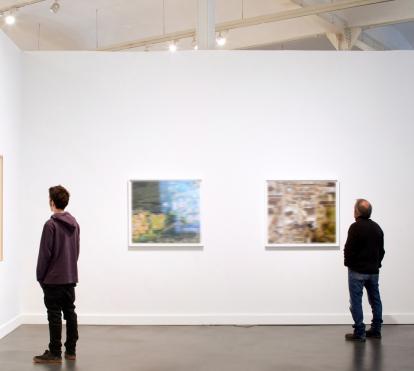
Visual Arts: 19th century photography in Spain
15.04.03
5 minutes read"Our busy century doesn't always have time to read, but it does have time to see," said Theóphile Gautier in 1858. Two decades beforehand, the first photographic procedure (the daguerreotype) had swept through Europe, and with it the figure of the spectator, fascinated by the optical qualities of the new invention. At the same time that society was becoming faster, more mechanised, images were gaining ground over printed words. Photography's capacity for synthesis and its evocative qualities quickly turned it into one of the public's favourite forms of visual expression. The exhibition 19th century photography in Spain shows the impact of the invention of photography, as well as the excitement it sparked throughout the 19th century. The display consists of 165 photographs, most of them unpublished up to now, from archives, museums and private collections. Likewise, it offers a wealth of books, newspapers, magazines, albums and advertisements, reflecting their purpose and dissemination media. The exhibition is not intended as an all-inclusive overview of the work of each 19th century Spanish photographer, nor is it meant to be interpreted in thematic terms. Rather, it is a simple attempt to show the various uses and roles attached to photography in that period.The exhibition 19th century photography in Spain, organised by Juan Naranjo, can be visited at CaixaForum (avenida del Marquès de Comillas, 6-8), from 16 April to 6 July 2003.This exhibition is the result of research efforts carried out by independent organiser Juan Naranjo. In his words, "Photography radically altered the knowledge that 19th century society had about the world. Photography made visual portrayals more democratic, while also identifying, accusing and bringing the image of others closer. It brought the interiors of palaces, mansions and more humble dwellings into the public eye. And it was the medium that best represented and participated, in form and content, in the most significant transformations that took place in modern creation throughout the 19th century, which later gave way to the avante-garde movements of the 20th century," 19th century photography in Spain is divided into three conceptual ambits: Modernity, Identity and From private to public pictures. It features the work of the first foreign photographers to set foot in Spain, as well as that of locals, along with a great many anonymous shots. Through these pictures, the exhibition not only means to recreate the atmosphere of expectation and innovation that came with the dawn of photography, but also invites the viewer to delve into the work of the forerunners of certain contemporary photographic idioms. IdentityIn the mid-19th century, Spain was among the preferred destinations for French and English tourists, as is shown by the wealth of travel books and guides from the period. Romantic writers and painters had created a stereotypical image of Spain, and many photographers intentionally echoed such clichés, projecting the image of a markedly reductionist country: bullfighters, bandits, gypsies, cigarette girls, views of Moorish ruins, etc. Théophile Gautier was one of the first to take photographs later marketed as stereotyped images of Spain. These panoramas did not match the reality of a country with a rich, diverse cultural fabric, which explains why industrial, Europeanised cities such as Barcelona were overlooked, as the technological progress prevalent there did not fit the cliché.Photographs of criminals, natives (from the colonies), the bourgeoisie and Queen Elizabeth II, in addition to those incorporated into documents meant for identification, pictures taken under the pretence of anthropological studies and various self-portraits also form part of the exhibition's Identity section. On the occasion of the 1888 World's Fair of Barcelona, Rafael Areñas took many of the portraits that were attached to the passes for admission to the fairgrounds. These passes, which featured the individual's name and signature, are the ancestors of today's ID cards. Previously, Julián de Zugasti, civil governor of Córdoba, used photography to fight crime by commissioning Cordovan photographer J.H. Tejada to take portraits of all captured criminals.From private to public picturesThe advent of photography made it possible to attach faces to a great many anonymous individuals. This trend was accentuated after 1860, when techniques were perfected and costs dropped. It led to a certain democratisation of portraits and mass production of photographs of distinguished celebrities (monarchs, politicians, writers, actors, etc.). The most renowned portrait-makers began to sell photographs of leading figures of society, and acquiring them became a fad of that period. Likewise, works of art were no longer exclusively destined for churches, palaces, private collections and museums, as copies could be purchased in the book shops, news-stands and photographic studios of most Spanish cities.ModernityThe counterpoint to the romantic, idealised image projected by travellers visiting Spain was provided by the industrial photographs that reflect Spain's modernisation process, begun during the reign of Queen Elizabeth II. It was not by chance that photography became the predominant medium to portray the modernity that came with the scientific and technical progress of the industrial revolution, as it was taken as one of the greatest exponents of technological modernity. Photography was also employed by artists of the most critical, transgressive circles, who used it to document their activities or as a means of expression. These artists created a number of works whose innovative character puts them in a class above the standard production of the time. 19th century photography in SpainFrom 16 April to 6 July, 2003CaixaForumAv. Marquès de Comillas, 6-808038 Barcelonawww.fundacio.lacaixa.esTel.: 902 22 30 40Hours:Tuesday to Sunday, 10 am to 8 pmMonday, closedFree admissionwww.fundacio.lacaixa.es